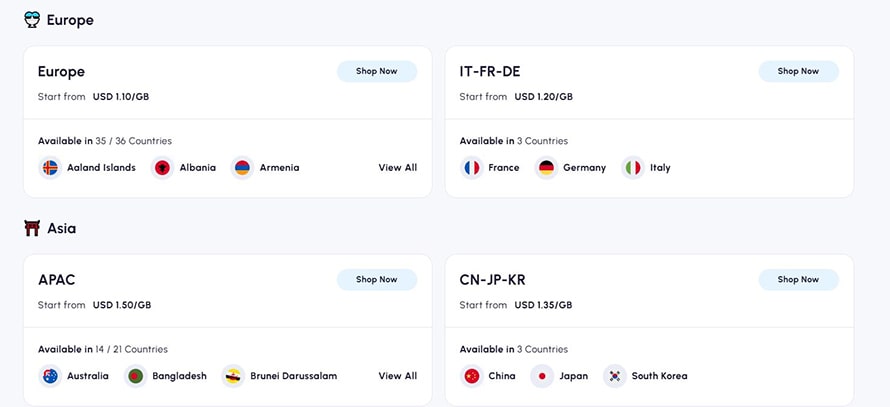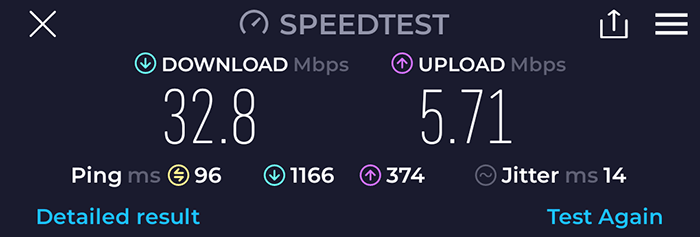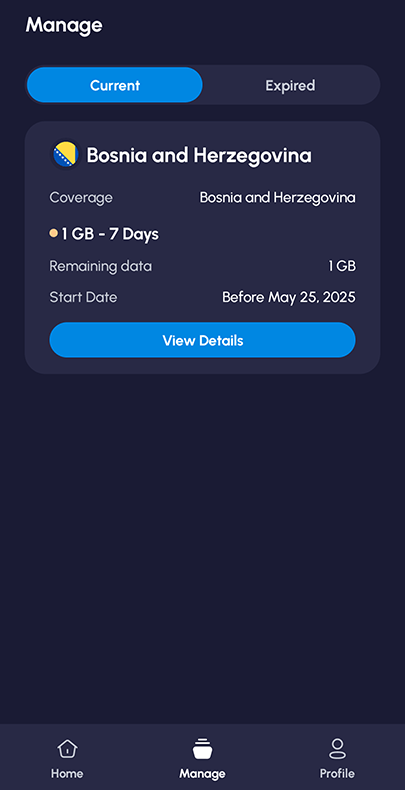
Nomad is an eSIM that provides you instant access to the internet at an affordable price while helping avoid the dreaded juggle involving physical cards. However, there are too many providers to choose from, so our Nomad review will attempt to clarify its position in this bustling industry by evaluating the main features and pricing.
Let's get started!
| Website | GetNomad.app |
| Pricing | Start at $4.50 for 30 days |
| Platform compatibility | Android and iOS |
| Number of countries | 190+ |
| Supported mobile networks | 5G, 4G, 3G, LTE |
| Are phone calls allowed | No |
| Is mobile hotspot supported | Yes |
Key takeaways from testing Nomad eSIM
- With data plans ranging from 1GB to 100GB and durations from 1 to 60 days, Nomad eSIM is super flexible and is great for both short trips and lengthy “adventures”.
- Nomad provides coverage in over 190 countries and boasts a user-friendly app for managing data expenditure and purchasing plans.
- Nomad’s pricing is competitive and transparent, though users report that customer support can be hit or miss.
- This service is data-only, which may be a significant drawback if you need to make traditional voice calls.
- Check out Nomad's latest deals and discounts on their pricing page to snag the best offers.
Overview of Nomad eSIM
As a data-only provider covering multiple regions and over 190 countries, Nomad eSIM was established in 2020. It quickly became one of the hard hitters in the industry, with users praising its straightforward approach, intuitive mobile app, and affordability.
While Nomad practically screams convenience, the fact it’s data-only may disqualify it as an option for users who seek the full experience of the traditional SIM. According to some, customer support is fairly uneven with its help.
Here’s the full pros and cons list:
+Pros
- Extensive global coverage
- Affordable pricing
- Ample choice of plans
- User-friendly app
- Multi-device support
- Discounts for bundle purchases
-Cons
- No SMS or voice call support
- Connectivity issues in some regions
Key features of Nomad's eSIM technology
Nomad packs a hefty punch with a mix of features that make it a prime pick for travelers. From solid speeds and flexible plans to multi-device support, Nomad can easily fulfill the needs of users of varying requirements.
Let’s check out some details.
Flexible data plans
Regardless of where you’re traveling, Nomad probably has a plan that checks all the boxes. Data plans range from as little as 1GB to as much as 100GB, with the flexibility also extending to plan durations – from one day all the way to 60 days.
In addition to country-specific plans, Nomad offers regional plans covering multiple countries and a massive global plan that covers every country in Nomad’s network. All of this combined makes the service versatile, allowing you to find a plan that perfectly addresses your connectivity needs when traveling.
Best of all, the pricing is transparent and you’ll never have to contend with any hidden fees. The app makes it easy to monitor your data usage, so you won’t ever find yourself in a situation where you’re charged extra or stranded in a foreign country with no internet connection.
With Nomad accepting multiple currencies, grabbing internet data on the go is a breeze for international travelers.
Extensive coverage
This Nomad review would be useless if it didn't mention the service's coverage, so here goes.
With support in over 190 countries, Nomad makes staying connected easy no matter where you roam. The service keeps it simple – you can relax and enjoy the peace of mind that comes with reliable connections everywhere.

Nomad covers all regions, including North America, Asia, and Europe, as well as all the popular travel destinations, such as:
- USA
- UK
- Italy
- Australia
- Japan
- Thailand
- Singapore
- China
- Germany
Multi-device support
What makes Nomad stand out is that users can share eSIM plans across multiple devices. In other words, if you rely on your laptop when traveling, Nomad has got you covered.
This can indeed be easily replicated with other eSIMs by firing up a hotspot on your phone, but it’s still something we count as a notable benefit.
Pricing
You’ll be happy to learn that this provider is also known for its competitive pricing, with plans generally running at $2 per GB on average.
In some regions, this may be more cost-effective than tracking down a local SIM card. In others, it may be more expensive, but we’re still of the opinion that the convenience you get is worth the extra couple of bucks.
Before we take a more detailed look at the prices, it’s worth stressing they can vary according to the region.
| Region | Data amount | Duration | Price |
| Global | 1GB | 7 days | $12 |
| Global | 5GB | 30 days | $36 |
| Global | 20GB | 365 days | $68 |
| Europe | 1GB | 7 days | $5 |
| Europe | 5GB | 30 days | $14 |
| Europe | 30GB | 365 days | $49 |
| USA | 1GB | 7 days | $4.50 |
| USA | 5GB | 30 days | $14 |
| USA | 20GB | 30 days | $22 |
See the latest Nomad prices and deals here >
User experience and performance
When choosing an eSIM provider, performance and user experience should be among the key deciding factors. You can breathe a sigh of relief here as dealing with Nomad is overwhelmingly positive.
For example, over 8000 people have left favorable reviews on Trustpilot where Nomad currently has a user score of 4.5 out of 5.
We concur with the user sentiment as our entire experience was super smooth – from the installation itself to using the app.
The same goes for dealing with customer support. Nomad offers 24/7 service in that regard and is generally responsive. Despite that, a minority of users online have noted that the effectiveness is inconsistent.
When testing the responsiveness of customer support, we ran into no issues whatsoever.

“Escaping” the chatbot took a minute or two, but after a few messages, a human agent entered the chat and answered our query professionally and confidently, as you can see:

The ordeal took three minutes tops, which is a good sign. Realistically speaking, if you encounter any problems with your eSIM, the chatbot will probably be enough to resolve it. However, knowing a professional is a few taps away is comforting.
Connectivity and speed
Cheap prices and flexible plans fall into the water if your eSIM service is slow and unreliable. Thankfully, Nomad excels in this area as well, with solid connectivity and network reliability.
Nomad generally provides 4G and in some areas even 5G. This is purely dependent on your travel destination and network conditions, so you shouldn’t expect to receive 5G in a rural village in Europe. The reason why is simple – Nomad partners up with local cellular providers for coverage. Thus, you should redirect potential rage about the speed at local cellular companies.
Here’s what we got:

While not the fastest download speed in the world (this is more or less the same network quality you'd get with a local mobile plan in the location where we conducted the test), connections through Nomad are stable – we experienced no dropouts during our use.
Some users complained about throttling (which we haven’t noticed), but this also doesn’t have much to do with Nomad as it has to do with local providers.
Since throttling occurs when ISPs determine you’re using too much data, you can circumvent this issue by connecting to the internet using a VPN – our rundown of the best VPN services is a must-read for that.
App usability
Nomad is user-centric, a fact apparent with just one glance at its app:

The three tabs are all you need to purchase new data plans (if needed), manage your data expenditures, add some extra GBs if you’re running low, or contact customer support if you run into any hiccups. We especially like the fact you can contact customer support from anywhere in the app by tapping on the headset icon.
No matter your tech skills, you'll master this app in no time – kudos to Nomad for making it so user-friendly.
Compatible devices for Nomad eSIM
Most modern phones support eSIM technology. This includes all the latest iPhones (starting with iPhone 11) and Samsung Galaxy devices, as well as Google Pixel (starting with Pixel 3). Most modern models from manufacturers like Honor and Xiaomi are also eSIM-compatible.
Unfortunately, eSIMs won’t work on carrier-locked devices.
How to set up and use Nomad eSIM
Installing an eSIM is relatively straightforward. The first step is downloading the Nomad app from your app store of choice, followed by choosing a region and plan, signing up for a Nomad account, and making the payment.

Your eSIM will install when you tap the ‘Add an eSIM to your phone’, but you can also install it by scanning the QR code you receive via email.

Just go to your network & internet settings, find the SIM section, and hit the plus icon to add a new eSIM. You’ll then be prompted to scan the QR code and that’s it.
You can activate the data plan when you arrive at your destination. Navigate to the SIM section of your network & settings (cellular on iOS) and you’ll be able to find Nomad in the list of options.

Tap on it, turn it on via slider, enable data roaming and mobile data, and you’ll connect to the internet.
Advantages of choosing Nomad eSIM
To eSIM or not to eSIM, that is the question – and the answer is obvious in our book.
With an eSIM, you’ll have a stable internet connection as soon as you arrive, which is everything you need to understand why this technology is such a godsend.
Using Nomad’s service simply offers a new level of convenience. Standard SIM cards are not only finicky, but it can really be a hassle to deal with local vendors as you travel – more so in countries where locals have limited English-speaking skills.
An underrated advantage of eSIMs is that they’re eco-friendly. Physical SIMs are not only made of plastic (which you’ll probably discard once you get back from the trip) but they also sometimes come in plastic packaging. As such, switching to Nomad will reduce your carbon footprint and you’ll sleep easy knowing you’re doing your bit in saving the planet.
Comparison with competitors
As we said in the very beginning, Nomad is just one of the eSIM providers in the market you can choose from. Although it’s one of the finest, there is some stiff competition.
| Provider | Voice call support | Extra features | Price |
| Nomad | No | Discount for bundle purchases | $4.50 for 1GB |
| Saily | No | Ad blocker, VPN, web protection | $1.99 for 1GB |
| Airalo | Global plan only | Loyalty and referral program | $4.50 for 1GB |
| AloSIM | Yes | / | $4.50 for 1GB |
| Holafly | No | Unlimited data | $6.90 per day for unlimited data |
Now, for the sake of keeping this Nomad review as objective as possible, we have to mention that you should look beyond the price. While a solution like Holafly is much more expensive, it also comes with unlimited data and voice call support. On the other hand, aloSIM is equally priced as Nomad but also offers voice call support.
A similar thing applies to Saily. This service is not only cheaper (when using our exclusive Saily coupon), but it also offers complementary security features that include VPN functions, an ad blocker, and threat protection – which you can read about in our Saily review.
Summary – Simple and incredibly affordable
If you don’t want to pay too much money for data and require plenty of flexibility, then Nomad is your best bet. Complaints about customer support notwithstanding, the overall sentiment surrounding the service is very favorable.
Regardless of where you’re traveling and how long, this eSIM will do its job and provide convenient online access without putting a dent in your wallet. Plus, it’s user-friendly and doesn’t require fiddling around – perfect for those who want services that work straight “out of the box” without too much hassle.
Take it for a spin on your next adventure and enjoy the freedom that an eSIM of such a caliber can provide – you’ll thank us later.
Other eSIM Guides:
- Saily Review
- Airalo Review
- Jetpac Review
- aloSIM Review
- Holafly Review
- Ubigi eSIM Review
- Best eSIM Providers
- Best eSIM for Europe
- Best eSIM for Japan
- Best eSIM for USA
- Best eSIM for International Travel
Nomad eSIM FAQs
How do I install a Nomad eSIM?
First, make sure your phone supports eSIM (most newer iPhones and Android devices do). Once you're all set, download the Nomad app, create your account, and head to the “Manage eSIM” page. Select the eSIM plan you want, tap “Installation Instructions,” and choose “Add automatically.” Then, hit “Install eSIM Now” and follow the simple on-screen steps.
You'll be up and running in no time, ready to stay connected on your travels.
What kind of plans does Nomad offer?
Nomad offers flexible data plans from 1GB to 100GB, lasting between 1 to 365 days, with regional, global, and local options. So, whether you need short-term or long-term data, Nomad has got you covered.
Is customer support available 24/7?
Yes, Nomad provides 24/7 customer support in English, so you can reach out whenever you need assistance. You can contact them through the in-app chat on both the Nomad Android and iOS apps, or use the website chat for support.
To ensure you don't miss any responses, it's a good idea to enable push notifications on your device.
Can I use Nomad eSIM for voice calls and SMS?
You can't use Nomad eSIM for voice calls or SMS, since this service is data-only.
How much does Nomad eSIM cost?
Nomad offers some seriously affordable eSIM options, with prices that depend on the region and how much data you need. For example, a 3GB plan for 7 days will only set you back $12, which is a great deal for short trips.
In some regions, rates can start as low as $4.50 per GB – talk about budget-friendly. The pricing structure is based on the data you choose and the duration of your plan, so whether you're traveling for a few days or a few weeks, there’s a plan to fit your needs without breaking the bank.
This Nomad eSIM review was last updated on March 28, 2025.

Leave a Reply